World Roundup
September/October 2015


-
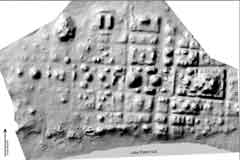 GUATEMALA: The ancient Maya city of Nixtun-Ch’ich’ in Petén stands out not for its flat-topped pyramids, but for its plan. Years of excavation and mapping have revealed that Nixtun-Ch’ich’ was built on a modern-style grid, which makes it unique among urban Maya sites. The level of organization suggests that it had a powerful ruler or state, and that life there could have been markedly different than in other Maya cities, which tend to be more spread out and spacious. —Samir S. Patel
GUATEMALA: The ancient Maya city of Nixtun-Ch’ich’ in Petén stands out not for its flat-topped pyramids, but for its plan. Years of excavation and mapping have revealed that Nixtun-Ch’ich’ was built on a modern-style grid, which makes it unique among urban Maya sites. The level of organization suggests that it had a powerful ruler or state, and that life there could have been markedly different than in other Maya cities, which tend to be more spread out and spacious. —Samir S. Patel -
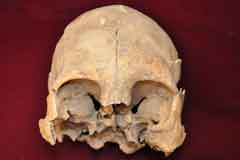 BOLIVIA: Three skulls found near Lake Titicaca, at Wata Wata, occupied from a.d. 200 to 800, stand out among Andean trophy skulls for the violence done to them and for their association with Tiwanaku culture, for which there was no prior evidence of head-taking. The skulls of three adults show evidence of scalping, beheading, defleshing, and even the forcible removal of the eyes, all around the time of death. Whoever they were, the trauma likely served to symbolically disempower them—in this life and perhaps the next. —Samir S. Patel
BOLIVIA: Three skulls found near Lake Titicaca, at Wata Wata, occupied from a.d. 200 to 800, stand out among Andean trophy skulls for the violence done to them and for their association with Tiwanaku culture, for which there was no prior evidence of head-taking. The skulls of three adults show evidence of scalping, beheading, defleshing, and even the forcible removal of the eyes, all around the time of death. Whoever they were, the trauma likely served to symbolically disempower them—in this life and perhaps the next. —Samir S. Patel -
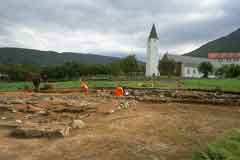 ICELAND: A team studying medieval monastic and religious sites on the island has found that monks and nuns preferred to secrete themselves away rather than share sites with common churchgoers. Because the island has historically been so sparsely populated, it was assumed that monks and nuns would have used everyday parish churches, rather than build their own. The new work indicates that monastic cloisters weren’t built near parish churches, suggesting that monks and nuns went to great, expensive lengths to build their own churches and isolate themselves. —Samir S. Patel
ICELAND: A team studying medieval monastic and religious sites on the island has found that monks and nuns preferred to secrete themselves away rather than share sites with common churchgoers. Because the island has historically been so sparsely populated, it was assumed that monks and nuns would have used everyday parish churches, rather than build their own. The new work indicates that monastic cloisters weren’t built near parish churches, suggesting that monks and nuns went to great, expensive lengths to build their own churches and isolate themselves. —Samir S. Patel -
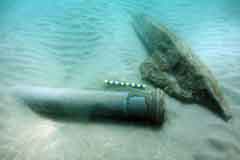 IRELAND: Recent storms have placed at risk the remains of three ships from the famed Spanish Armada that were wrecked during a storm in 1588, taking more than 1,000 lives. Discovered in 1985, the wrecks—La Juliana, La Lavia, and La Santa Maria de Visón—have in recent years disgorged artifacts onto the beach: a rudder, a cannonball, timbers, and more. In response, the country’s Underwater Archaeology Unit has raced to retrieve items exposed by shifting sands, including cannons from La Juliana, a converted merchant vessel. —Samir S. Patel
IRELAND: Recent storms have placed at risk the remains of three ships from the famed Spanish Armada that were wrecked during a storm in 1588, taking more than 1,000 lives. Discovered in 1985, the wrecks—La Juliana, La Lavia, and La Santa Maria de Visón—have in recent years disgorged artifacts onto the beach: a rudder, a cannonball, timbers, and more. In response, the country’s Underwater Archaeology Unit has raced to retrieve items exposed by shifting sands, including cannons from La Juliana, a converted merchant vessel. —Samir S. Patel -
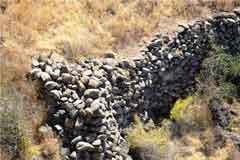 ZIMBABWE: New investigations at the remote site of Mapela are providing insights into the origins of the Zimbabwe culture, known for its elite stone terrace houses surrounded by dwellings for commoners, most notably seen at the ruins of Great Zimbabwe. Mapela, a largely forgotten site, dates to the 11th century and suggests that the culture’s signature class hierarchy and distinctive architecture arose some 200 years earlier than expected. —Samir S. Patel
ZIMBABWE: New investigations at the remote site of Mapela are providing insights into the origins of the Zimbabwe culture, known for its elite stone terrace houses surrounded by dwellings for commoners, most notably seen at the ruins of Great Zimbabwe. Mapela, a largely forgotten site, dates to the 11th century and suggests that the culture’s signature class hierarchy and distinctive architecture arose some 200 years earlier than expected. —Samir S. Patel -
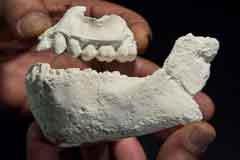 ETHIOPIA: Parts of jaws and teeth found in the Afar region—near where Lucy, the famed Australopithecus afarensis, was discovered in 1974—may represent a new human ancestor. Dubbed Australopithecus deyiremeda, the new species, which dates to between 3.3 and 3.5 million years ago, may have coexisted with Lucy’s species, but appears to have been adapted to take advantage of tougher plants and grasses than A. afarensis. The differences are subtle, so more research and samples are needed to understand the evolutionary place of the new species. —Samir S. Patel
ETHIOPIA: Parts of jaws and teeth found in the Afar region—near where Lucy, the famed Australopithecus afarensis, was discovered in 1974—may represent a new human ancestor. Dubbed Australopithecus deyiremeda, the new species, which dates to between 3.3 and 3.5 million years ago, may have coexisted with Lucy’s species, but appears to have been adapted to take advantage of tougher plants and grasses than A. afarensis. The differences are subtle, so more research and samples are needed to understand the evolutionary place of the new species. —Samir S. Patel -
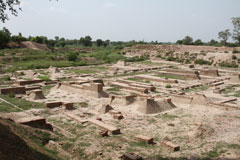 PAKISTAN: Compared with the other cradles of civilization in Egypt and Mesopotamia, little is known about the people of the Indus Valley civilization, in large part because of the lack of elaborate burials and because their script remains undeciphered. A recent isotope analysis of teeth from Indus burials shows that people interred there were almost exclusively migrants from the hinterlands. The pattern suggests some kind of formalized migration, and that the remains of these people were treated differently (buried) than those of locals, which aren’t preserved in the archaeological record. —Samir S. Patel
PAKISTAN: Compared with the other cradles of civilization in Egypt and Mesopotamia, little is known about the people of the Indus Valley civilization, in large part because of the lack of elaborate burials and because their script remains undeciphered. A recent isotope analysis of teeth from Indus burials shows that people interred there were almost exclusively migrants from the hinterlands. The pattern suggests some kind of formalized migration, and that the remains of these people were treated differently (buried) than those of locals, which aren’t preserved in the archaeological record. —Samir S. Patel -
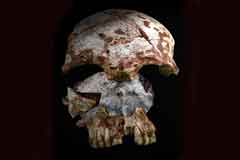
LAOS: Skull fragments recovered from a cave represent the earliest known modern human in Southeast Asia. Between 46,000 and 63,000 years old, the find is better dated and more clearly modern than similar fossils that have been found in East Asia. The bone was found in the north of the country, which suggests that the previous assumption that early modern humans migrated solely along the coast is incomplete, and that they spread into a range of environments early in the migration out of Africa. —Samir S. Patel
-
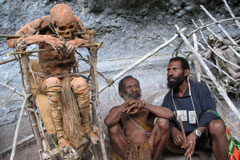 PAPUA NEW GUINEA: Mummies are created around the world, usually by some form of drying. Among the Anga people of the Aseki region, mummies are smoked. Until recently, the Anga smoked the deceased and displayed their bodies on cliffsides out of reverence and to mark territory, but exposure to the elements has left them deteriorated. Researchers from the United States and Canada recently helped conserve one, a leader named Moimango, using materials found in the jungle. The project was a success, and Moimango now sits again in the cliffside roost where he has overseen his descendants for some 60 years. —Samir S. Patel
PAPUA NEW GUINEA: Mummies are created around the world, usually by some form of drying. Among the Anga people of the Aseki region, mummies are smoked. Until recently, the Anga smoked the deceased and displayed their bodies on cliffsides out of reverence and to mark territory, but exposure to the elements has left them deteriorated. Researchers from the United States and Canada recently helped conserve one, a leader named Moimango, using materials found in the jungle. The project was a success, and Moimango now sits again in the cliffside roost where he has overseen his descendants for some 60 years. —Samir S. Patel -
 AUSTRALIA: In 1916, Australian soldiers were preparing to make their name on the world stage, fighting for the Allies in WWI (such as at Gallipoli, shown here). But first they had to train for the trenches. Near Canberra, archaeologists have uncovered evidence of this preparation. Using aerial photos, researchers identified and have begun to excavate an area where Australian soldiers dug training trenches. Their dig is revealing how the military experimented with trench styles, and then trained soldiers to re-create them in the field. —Samir S. Patel
AUSTRALIA: In 1916, Australian soldiers were preparing to make their name on the world stage, fighting for the Allies in WWI (such as at Gallipoli, shown here). But first they had to train for the trenches. Near Canberra, archaeologists have uncovered evidence of this preparation. Using aerial photos, researchers identified and have begun to excavate an area where Australian soldiers dug training trenches. Their dig is revealing how the military experimented with trench styles, and then trained soldiers to re-create them in the field. —Samir S. Patel
Advertisement
IN THIS ISSUE
Features
Golden House of an Emperor
New York's Original Seaport
Cultural Revival
Letter From England
From the Trenches
Bronze Age Ireland’s Taste in Gold
Off the Grid
A Rare Bird
Atacama’s Decaying Mummies
Bronze Age Traveler
Great Lakes Shipwreck Spotting
Early Parrots in the Southwest
The Red Lady of El Mirón
For the Love of a Noblewoman
Blood on the Ice
Under the Rug
What’s in a Name?
A Place to Hide the Bodies
“T” Marks the Spot
As American as Sliced Bacon in a Can
Surely You Joust?
Artifact
The dragon that guarded Xanadu
Advertisement

Recent Issues
-
 May/June 2024
May/June 2024
-
 March/April 2024
March/April 2024
-
 January/February 2024
January/February 2024
-
 November/December 2023
November/December 2023
-
 September/October 2023
September/October 2023
-
 July/August 2023
July/August 2023
-
 May/June 2023
May/June 2023
-
 March/April 2023
March/April 2023
-
 January/February 2023
January/February 2023
-
 November/December 2022
November/December 2022
-
 September/October 2022
September/October 2022
-
 July/August 2022
July/August 2022
-
 May/June 2022
May/June 2022
-
 March/April 2022
March/April 2022
-
 January/February 2022
January/February 2022
-
 November/December 2021
November/December 2021
-
 September/October 2021
September/October 2021
-
 July/August 2021
July/August 2021
-
 May/June 2021
May/June 2021
-
 March/April 2021
March/April 2021
-
 January/February 2021
January/February 2021
-
 November/December 2020
November/December 2020
-
 September/October 2020
September/October 2020
-
 July/August 2020
July/August 2020
-
 May/June 2020
May/June 2020
-
 March/April 2020
March/April 2020
-
 January/February 2020
January/February 2020
-
 November/December 2019
November/December 2019
-
 September/October 2019
September/October 2019
-
 July/August 2019
July/August 2019
-
 May/June 2019
May/June 2019
-
 March/April 2019
March/April 2019
-
 January/February 2019
January/February 2019
-
 November/December 2018
November/December 2018
-
 September/October 2018
September/October 2018
-
 July/August 2018
July/August 2018
-
 May/June 2018
May/June 2018
-
 March/April 2018
March/April 2018
-
 January/February 2018
January/February 2018
-
 November/December 2017
November/December 2017
-
 September/October 2017
September/October 2017
-
 July/August 2017
July/August 2017
-
 May/June 2017
May/June 2017
-
 March/April 2017
March/April 2017
-
 January/February 2017
January/February 2017
-
 November/December 2016
November/December 2016
-
 September/October 2016
September/October 2016
-
 July/August 2016
July/August 2016
-
 May/June 2016
May/June 2016
-
 March/April 2016
March/April 2016
-
 January/February 2016
January/February 2016
-
 November/December 2015
November/December 2015
-
 September/October 2015
September/October 2015
-
 July/August 2015
July/August 2015
-
 May/June 2015
May/June 2015
-
 March/April 2015
March/April 2015
-
 January/February 2015
January/February 2015
-
 November/December 2014
November/December 2014
-
 September/October 2014
September/October 2014
-
 July/August 2014
July/August 2014
-
 May/June 2014
May/June 2014
-
 March/April 2014
March/April 2014
-
 January/February 2014
January/February 2014
-
 November/December 2013
November/December 2013
-
 September/October 2013
September/October 2013
-
 July/August 2013
July/August 2013
-
 May/June 2013
May/June 2013
-
 March/April 2013
March/April 2013
-
 January/February 2013
January/February 2013
-
 November/December 2012
November/December 2012
-
 Sep/Oct 2012
Sep/Oct 2012
-
 September/October 2012
September/October 2012
-
 July/August 2012
July/August 2012
-
 May/June 2012
May/June 2012
-
 March/April 2012
March/April 2012
-
 January/February 2012
January/February 2012
-
 November/December 2011
November/December 2011
-
 September/October 2011
September/October 2011
-
 July/August 2011
July/August 2011
-
 May/June 2011
May/June 2011
-
 March/April 2011
March/April 2011
-
 January/February 2011
January/February 2011
Advertisement






